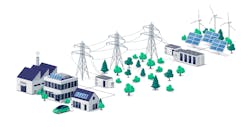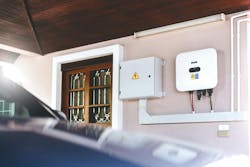Are Virtual Power Plants the Solution to the Grid’s Energy Crisis?
It is no great secret that the U.S. electric grid must address a trifecta of critical issues in the coming years.
First, there’s the rapid retirement of the country’s aging fleet of traditional power plants. The U.S. aims to retire 5.2 GW of capacity this year alone, 91% of which will come from shuttered coal and natural gas plants. Close to 5 GW of U.S. nuclear power capacity has been retired since 2017, according to the U.S. Energy Information Administration.
Second, utilities are facing increased pressure to decarbonize and integrate more renewable energy resources.
Last, but certainly not least, there’s an impending explosion in demand for electricity. The U.S. Department of Energy (DOE) predicts coincident peak demand will rise by around 60 GW between 2023 and 2030.
Much of this demand will be driven by the growth of energy-hungry data centers. Electric vehicle adoption is also expected to increase as will the electrification of homes and businesses.
The grid, in its current iteration, will be hard-pressed to keep up with all this demand.
Virtual power plants (VPPs) have emerged as one of the leading solutions to the monumental task facing the energy industry and, while they offer many potential benefits, not everyone is sold on VPPs being the best path forward.
Billions of connected devices
VPPs use advanced software and communication technologies to manage, optimize and coordinate the output of tens, hundreds or even thousands of distributed energy resources (DERs) into a single, aggregated dispatchable resource that can be used to bolster the grid during times of peak demand.
In fact, the DOE says that deploying between 80 GW and 160 GW of VPPs between now and 2030 – essentially tripling the current scale – could meet up to 20% of that 60 GW of increased demand it foresees.
VPPs typically include three categories of DERs, according to Cisco DeVries, vice president of RenewHome, a new entity created by the merger of Google Nest’s Renew and OhmConnect that says it’s the largest residential VPP in North America.
The first category includes rooftop solar and storage systems. Energy storage is essential because it makes the power generated by a rooftop array dispatchable, DeVries said.
The second category includes heating, ventilation and air conditioning (HVAC) systems. Controlled by smart thermostats, HVAC systems participate in VPPs by raising or lowering the temperature in a home or business during peak times, ultimately reducing demand.
The third category includes smart home devices such as appliances, televisions, smart lights and more. “Anything in your home that can be controlled to reduce load at key times when the grid is congested, dirty and expensive can be part of a virtual power plant,” DeVries said.
Democratizing energy
VPPs reduce demand or create supply where it is needed, and they moderate and manage distribution systems, according to DeVries, who added “they’re a true wires alternative.”
Not only will they help the grid stay in balance, but VPPs can also help consumers lower their energy bills by adjusting energy use in real time.
In fact, the Brattle Group recently found that by 2035 VPPs will have the potential to save Californians more than $550 million on their electric bills each year.
Consumers are also compensated for their participation in a VPP.
“What I like about the virtual power plant approach is that it is incredibly democratic,” DeVries said. “Everybody gets to participate and their kilowatts are worth the same” regardless of their income level.
Incentive payments could range between $500 to $1,000 per year, according to the Brattle Group.
While VPPs are a radically different approach to energy delivery when compared to the centralized system we’ve had for more than 100 years, DeVries believes consumers will jump on board.
“If everything you plug in in your home is essentially a mini little ATM machine that can pay you, once you get the hang of that, you're going to want to plug more things into the ATM machine,” DeVries said.
And because just about every device brought into a home these days is Wi-Fi-connected, it won’t be long before there will be billions of devices available to participate in VPPs.
Are VPPs the future of the grid?
For many, VPPs could be the future or at least a big part of the future of the grid.
“We have an enormous problem that is getting bigger. The solutions are to build more fossil fuel plants, build batteries and virtual power plants,” said DeVries. “VPPs are almost without any question the cheapest, fastest and cleanest [solution] for the U.S. grid to remain stable,” DeVries said.
Utilities, such as Puget Sound Energy (PSE) and San Diego Gas & Electric (SDG&E), seem to agree that VPPs have a role to play. Or they’re at least exploring the opportunities.
PSE, Washington state’s largest utility, recently expanded its VPP partnership with cleantech software company AutoGrid, and SDG&E is running a VPP pilot project to help the grid meet electricity demand when summer temperatures rise.
Grid operators are also investing in VPP technology. The Public Utility Commission of Texas announced two VPP pilot programs that will become dispatchable power resources for the Electric Reliability Council of Texas during times of high demand, and CPower Energy, a Baltimore-based energy management firm, is creating VPPs for the New York Independent System Operator that will be bid into the New York DER Participation Model.
But not everyone is on board with a VPP takeover of the grid.
“VPPs are solving today’s problems with yesterday’s solutions,” said Kay Aikin, founder and CEO of Dynamic Grid, an advanced distributed energy resource management systems company that’s using artificial intelligence to improve the coordination and optimization of DERs.
Increased demand, coupled with those soon-to-be billions of connected devices, are making the grid more volatile and exponentially more complex, Aikin said.
“It’s already the most complex machine in the world; we need to simplify it rather than make it more complex,” she said.
The problem with VPPs
Aikin sees several problems with the VPP approach, with perhaps the biggest being around infrastructure.
With FERC Order 2222, the U.S. Federal Energy Regulatory Commission paved the way for the participation of DERs in the capacity, energy and ancillary services markets. In short, the order makes it possible for VPPs to participate in energy markets just like a traditional power plant.
But the order didn’t establish any rules of the road, Aikin said, which created a problem for system operators.
“In VPP world, [dispatching] a battery or turning a heat pump down are the same thing” because you’re balancing supply and demand by either increasing the amount of available power or reducing demand, she explained.
However, “on the circuit, they are two very, very different things,” she said.
VPPs connect DERs located on multiple circuits, dispatching the power as one unit when called upon. That means that if a VPP has a controllable heat pump on circuit A and a battery on circuit B, demand from the heat pump is cut at the same time the energy in the battery is dispatched. But if circuit B doesn’t have enough thermal capacity to handle the load from the battery, the transformer is blown, Aikin explained.
“Somehow, we have to coordinate the [VPP’s] response circuit by circuit. I think that will make the system so complex it will collapse under its own weight,” she said.
Another layer
Aikin also believes there’s no need to add an intermediary between the consumer and the utility to manage customer-owned DERs.
Rather, she is a proponent of local distributed energy resource management systems where the controller, whether it be a microgrid controller or one built into a smart device in the owner’s home, responds to a price signal sent by the utility based on parameters set by the participant.
This approach to monitoring, coordinating and compensating on the distribution grid is a more bottom up solution, rather than the top down approach of VPPs.
“I think a much better way of doing it is to create an actual market platform on the distribution grid that the utility manages,” Aikin said. In her view, utilities should manage the system because they are regulated by public utility commissions that ensure customers are reimbursed if the utility makes too much money.
Everyone benefits
Both Aikin and DeVries agree that regardless of the approach, everyone needs to benefit from the reimagined grid – from the utility to the customer.
“We need everyone to be successful here … because the consequences are, at best, very dirty and hot and, at worst, very dark,” DeVries said.
About the Author
Kathy Hitchens
Special Projects Editor
I work as a writer and special projects editor for Microgrid Knowledge. I have over 30 years of writing experience, working with a variety of companies in the renewable energy, electric vehicle and utility sector, as well as those in the entertainment, education, and financial industries. I have a BFA in Media Arts from the University of Arizona and a MBA from the University of Denver.



